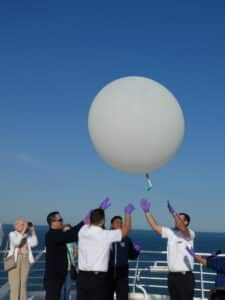Embarking on a Viking Expedition: A Client Review
We love It when clients send us their travel stories and we’re happy to share this Viking Cruise expedition from Jo Ann L.
Embarking on the Viking Expedition ship, Polaris, and cruising through the mesmerizing landscapes of the Great Lakes, from Toronto to Milwaukee, was a journey that shattered all my expectations. While Viking has long been known for its exceptional riverboat cruises across Europe, my adventure on Polaris unveiled an entirely new facet of luxury travel right here in the United States.
Step aboard Polaris, a true marvel classified as an Expedition Polar Class 6 vessel. Stretching a remarkable 665 feet with a 77-foot beam, this ship can comfortably accommodate 378 passengers. As I embarked on this voyage, accompanied by the ship’s sister, Octantis, which embarked on its maiden voyage in 2022, I was immediately struck by the ship’s purposeful design for expeditions. Beyond its opulent accommodations, Polaris houses a working lab where a team of dedicated scientists engage in cutting-edge research projects. This ship is truly a floating laboratory equipped with a “Hangar” that houses expedition equipment like kayaks, Zodiacs, and even a submarine. 
Imagine having the privilege to interact with experts conducting research in fields ranging from biology and botany to atmospheric sciences and glaciology. The Chief Scientist shared fascinating insights, highlighting how Polaris ventures to popular tourist destinations such as Antarctica, the Arctic Circle, the Great Lakes, and Alaska, all while conducting essential research. It’s an ingenious synergy where the voyage experiences and contributions of passengers like me contribute to the invaluable research and data gathering conducted on board.
One of the most captivating moments of the journey was witnessing the launch of a weather balloon during the early morning hours. This initiative is part of Polaris’ collaboration with the National Oceanic & Atmospheric Administration (NOAA) and its status as a registered weather balloon launch station for the US National Weather Service (NWS). These balloons, equipped with radiosonde sensors, ascend to astonishing heights, transmitting crucial atmospheric data that aids in weather forecasts and climate modeling on a global scale.
Yet, amidst its role as a research hub, Polaris does not compromise on luxury and hospitality for its guests. Our first port of call was the enchanting Port Colborne, where I was treated to the awe-inspiring beauty of Niagara Falls. The Rainbow Bridge provided a link to the U.S., offering stunning panoramic views of Horseshoe Falls, the heart of the falls’ grandeur. We marveled at the falls from the Escarpment, a famous cliff that extends from Rochester, NY, to the northwest of Chicago, shaping this natural wonder.
The ship’s World Café emerged as a bustling hub, an open “live kitchen” spread across half a deck. Here, skillful chefs worked their magic, baking, cooking, and grilling in open kitchens, crafting a medley of fresh foods, breads, pizzas, and delectable sweets. From a dedicated sushi area to a lavish seafood section and a customizable gelato bar, the Café satisfied every culinary desire. With such a plethora of culinary delights, there was little need to explore the ship’s three specialty restaurants.
Even our onshore experiences were marked by indulgence, with chocolates beckoning from every corner. From a delightful visit to a chocolate factory in Niagara-on-the-Lake to savoring fudges on Mackinac Island and experiencing a Chocolate Sommelier in Milwaukee, it was a paradise for the sweet-toothed traveler.
One of the most captivating shore excursions took me to Marquette University in Milwaukee, where the St. Joan of Arc Chapel resides. A relic of the 15th century, this chapel’s history is intertwined with the enigmatic Joan of Arc. Its transcontinental journey from Europe to New York, followed by meticulous reconstruction, stands as a testament to its enduring legacy.
A rivetig lecture by the Chief Scientist, titled “More Plastics or Fish?”, shed light on a pressing environmental concern. Exploring the three forms of microplastics that cling to organisms – primary, secondary, and fibers – she revealed the staggering impact of plastic on our oceans. With shocking statistics and insights into the persistence of plastics in our environment, this presentation underscored the urgent need for awareness and action.
And a unique tidbit – Canadian dollar bills are made of plastic, a countermeasure against counterfeiting, adding a quirky twist to the plastic narrative.
In retrospect, my expedition aboard Viking’s Polaris was a splendid revelation, blending scientific exploration, luxurious living, and awe-inspiring destinations into a seamless voyage. It’s an experience that redefined my perception of luxury travel and left an indelible mark on my wanderlust-seeking heart.
Jo Ann L is a client of Maha Rezkalla. Reach out to Maha to begin planning your next Viking Expedition!




